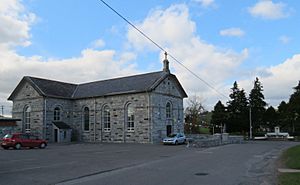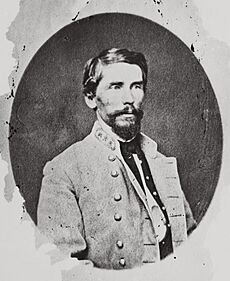Ovens, County Cork facts for kids
Quick facts for kids
Ovens
Na hUamhanna
|
|
|---|---|
|
Village
|
|

St. John The Baptist Church
|
|
| Country | Ireland |
| Province | Munster |
| County | County Cork |
| EU Parliament | South |
| Population
(2006)
|
1,703 |
| Time zone | UTC+0 (WET) |
| • Summer (DST) | UTC-1 (IST (WEST)) |
| Irish Grid Reference | W611704 |
Ovens (which in Irish is Na hUamhanna) is a small village in County Cork, Ireland. It is located right next to the town of Ballincollig. In 2006, about 1,703 people lived here. This was a big jump in population from just a few years before! Ovens is part of the Cork North-West area, which is how people are represented in the Irish parliament.
Ovens is also a civil parish, which is a traditional way of dividing land. The village is also home to a Roman Catholic parish with the same name.
Contents
Village History
Ovens has a long and interesting history. In 1837, a book called Lewis' Topographical Dictionary of Ireland described the area. It was known as Athnowen back then.
Location and Land
The village of Ovens is found on the road that goes from Cork to Macroom. It is bordered by the River Lee to the north and has the River Bride flowing right through it. The land around Ovens is quite varied. Some parts are hilly and stony, while others are very rich and fertile.
Underneath the ground, there is a lot of limestone. This limestone was important for the area. People used to quarry it, meaning they dug it out of the ground. Then they would burn it to make lime, which was used for building and improving farm land.
Old Buildings and Mills
Many important places were mentioned in the old records. Grange was a large house built where an old abbey once stood. An abbey is a type of monastery. There were also other important houses like Sirmount and Spring Mount.
The River Bride was also important for industry. There were two "boulting-mills" on the river. These mills were used to grind grain, like wheat, into flour. One was at Killumney and another was right in Ovens.
Churches and Schools
Ovens has a long history of community and education. The local church, which is an old and neat building, has a square tower. There was also a glebe-house, which is where the local priest or rector lived.
For the Roman Catholic community, a chapel was built in 1835. It was a beautiful building made of cut limestone. Schools were also very important. There were schools supported by the local church and a national school. These schools helped educate many children in the area.
Famous Caves
One of the most famous features near Ovens is its limestone caves. These caves are located near the bridge over the River Bride. An old history book from Cork described them as being quite tall, about 18 feet high. However, over time, they became partly filled with dirt and water.
The caves branch off into many different tunnels. Inside, you can see "stalactites" hanging from the roof. These are cool, icicle-shaped rock formations. No one has ever fully explored how big or how far these caves go! There are also some remains of an old castle nearby called Castle Inchy.

A famous person, Patrick Cleburne, was born in Ovens. He became a major general in the Confederate States Army during the American Civil War.
What's in Ovens Today?
Ovens is still mostly a rural area, meaning it has a lot of countryside and farms. However, it also has some modern amenities.
Local Sports
The local sports club is called Éire Óg. This club is very popular and plays traditional Irish sports like hurling and Gaelic football.
Jobs and Education
Farming is still a big part of the local economy. But there are also companies like EMC Corporation and John A. Wood Ltd. that provide jobs for people living in Ovens and the wider Cork area.
For education, there is one primary school called Ovens National School. The local Roman Catholic community is part of the Ovens / Farran parish.


